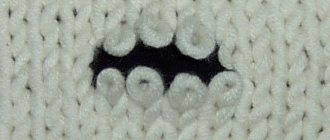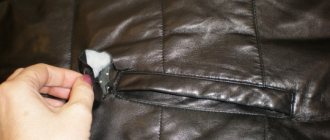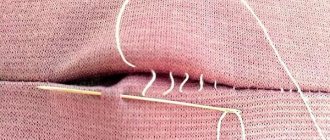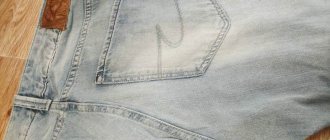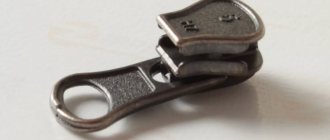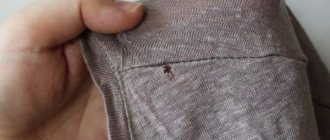Hole on hand knitwear
To repair hand-knitted knitted items, it is recommended to use a special knitted stitch. It is best to take the remnants of the threads from which it was knitted. If the tear is not the result of prolonged wear or a strong snag, it can be closed without anyone noticing.
To work, you need to prepare a hook and a needle with knitted thread.
The procedure is as follows:
- Pick up all missed stitches.
- Take a needle and thread and gather them in pairs, as if the fabric had not been torn.
- Bring the needle to the wrong side, make a few securing stitches, and cut off.
Large holes are closed with a needle step forward. It is made around the incision. This will allow the fabric not to tighten when sewing, and the basting itself will be pulled out during the work area.
To compensate for the volume, transverse threads are passed between the outer loops of the row. They create the basis for darning. When darning, loops are passed through each warp thread from the top to the end of the break. Then the hole is closed from bottom to top.
Invisible darning
On any clothing, but especially on knitwear, a tiny hole can appear out of nowhere and ruin the whole look. Most often they are discovered after washing. The thing is good, but you can no longer wear it, what should you do?
To prevent the hook from increasing in size, we will try to sew it up so that it is not visible. If you start working with simple threads, you can pull the material together and this place will catch your eye.
Let's not rush.
- Take the thinnest needle, the one used by bead embroiderers.
- Find tights that match the color of your T-shirt or are neutral.
Stages of work:
- Pull the thread out of the tights.
- Thread the needle using a threader. Don't tie a knot!
- We work from the front side of the product. Carefully collect all the loops with a needle. We catch them from below and from above, one loop at a time, then make a stitch without pulling the fabric.
- After finishing the darning, bring the needle to the wrong side.
- Secure the thread with a couple of stitches, then cut it off.
- Let's straighten the fabric and iron the repair area from the inside out. The nylon thread will melt slightly under the influence of high temperature, thereby closing the hole.
Hole on genuine leather
Leather is a durable fabric, but it can also be torn. Small holes can be glued from under the bottom with elastic material. Manually suturing such incisions is difficult and the seam will be too rough.
If you need to sew up leather, it is better to do it on a machine with a special foot. For such work they make beautiful decorative patches.
To do this, take 2 blanks:
- made of fabric, shaped slightly larger than the diameter of the tear. It is placed on the inside as a securing lining;
- leather, matching the size of the hole.
They need to be ground down carefully, without moving them relative to the product.
Hole in nylon tights
Thin material often tears or gets snagged. If there is no seal, then the product will tear on the toe and between the legs after the first wear. You have to throw it away or disguise it with long clothes. However, it is not always possible to purchase new tights, and you just have to sew them up yourself.
To do this you need:
- Take a thin needle and thread that matches the color of the product.
- Carefully pull the edges of the tear, trying to pick up all the missing loops.
- Insert the needle sequentially, without skipping any loops, to prevent further rupture.
- For strength, treat the seam with clear nail polish.
When tights have become unusable, the threads from them can be used for sewing other products.
Some useful tips
It is worth listening to the advice of experienced housewives:
- Be sure to turn the item inside out when you plan to sew it up. The front side of the item must be made perfectly, with invisible seams and knots.
- A seam ripper will be a great help when removing unnecessary stitches.
- Store needles correctly. They should be stuck into a pad or paper.
- Try to work on your own mistakes, because the first attempt may not always be successful.
- The thread should always be matched.
- Be sure to finish the work with the correct stitches, because if you leave the thread and do not fix it in any way at the end, the seam will simply fall apart.
If you are very worried and afraid to sew up the item yourself, then it is better to contact a tailor shop that will readily solve all problems with torn clothing.
Hole on lace and guipure
It is possible to restore a torn piece of lace or guipure, but it requires a lot of work.
It is important not to disturb the structure of the weave and therefore you need to know how best to make stitches. Lace repair begins with leveling the edges of the tear to prevent the mesh from breaking.
If the hole is invisible, then it is better to find a suitable piece of material and sew it from the bottom of the torn item using a thin thread.
You can sew up a hole without a seam if you know the weaving features. The thread is collected into bundles and the weaving pattern is recreated. Instead of bobbins, it is proposed to use spools on which you can throw yarn.
Teach your teenager how to choose the right needle
You need to select it according to the following principle:
- For thick and coarse fabrics, it is recommended to select a similar needle. That is, the one that will be spicy. And fat. This is necessary so that the teenager can easily pierce the clothes. Without putting an excessive amount of effort into it.
- For thin and delicate clothes, you can use absolutely any thread. Even the most ordinary ones. The teenager will be able to easily sew clothes with a similar structure.
Before starting to sew up a hole, a teenager should check the thread count
He must make sure that the thread is long enough. And it’s enough to sew up a hole in one go. To do this, the teenager needs to do the following manipulations:
- Take the thread in your hand. Apply it to the part of the clothing that is torn.
- Mentally add similar material 25 centimeters long to the attached thread.
Tell your teen to be mindful of sewing stitches. He must understand that these places require several times more thread. Therefore, if there is too little of it, there may not be enough material. And you won’t be able to sew up clothes the first time.
Also, a teenager needs to take into account the thickness of the fabric. The higher this indicator, the greater the number of threads needed to get rid of the hole. If the fabric is more than five millimeters thick, then the teenager will need to use threads that are twice as large.
Hole in jeans and pants
Thick fabric like denim can fray and tear. It is best to sew it up using the method of simulating thread weaving.
Tissue damage can occur in different places:
- on the knees;
- between the legs;
- in the pocket area;
- at the back point.
On your pocket
The pocket is a visible place, so it is necessary to sew up holes in it using creative ingenuity. It is best to choose an appropriately sized and interesting applique or do embroidery in a given place. The choice of method depends on the size of the tear and the level of fraying of its edges and where the hole is located.
Often holes appear in awkward places under or next to pockets. It can be inconvenient to sew them up or make a patch. Darning, patching or machine stitching in such cases looks rough.
Experts recommend using a piece of denim or a large button. It will cover the area that is sewn up.
Between the legs
The appearance of a hole between the legs is a common problem when wearing trousers and jeans. You can mend such places with a matching thread or by putting an inconspicuous patch.
You can do this by machine or by hand. When using the machine, you must carefully clean the edges from uneven threads and set the straight stitch mode. To make the seam less noticeable, it needs to be steamed after the operation.
If it is decided to install a patch, the material for it is selected that is most suitable in structure and color.
The actions will be as follows:
- Find the fabric and cut the patch to the desired size.
- Turn the product so that you can fully see the gap.
- Overcast the patch fabric with an overlog or a special machine function.
- Turn the product inside out and baste the patch face down.
- Sew along the edge and turn the pants right side out.
Along the seam
If the tear occurs along the seam of the jeans, then sewing it up will not be difficult. True, the material is too dense and difficult to sew by hand, but with the appropriate function of the sewing machine this can be done in a few minutes. The main thing is to clean the tear area from protruding threads and stitch the edges to each other.
The manual method of making a seam is as follows:
- Find a thread according to the color of the trim of the trousers that has a high density. Of course, the new seam will be on the inside and cannot be seen from the outside. But it's better to do everything beautifully.
- Connect the gap and baste with colored thread. You should get a straight line.
- The first stitch of a real seam is made from the inside. This way the knot will be invisible.
- Close the seam with alternating stitches connecting both sides.
- Having reached the end, make several securing stitches from the wrong side.
Behind
If the tear occurs at the back and not along the seam, to hide it, you must use darning or appliqué. This will make your favorite jeans fashionable. Moreover, you can get stylish pants, even if the hole is very frayed.
The procedure is as follows:
- Remove unnecessary threads and attach a suitable applique.
- Glue the reverse side with thin doubler tape.
- Attach the applique and run an iron over it if it is adhesive or sew on a machine if the fabric is heavy.
You can leave everything as is, decorating it with beautiful decor.
On my knee
When jeans are torn at the knee, they can be repaired in 2 ways:
| Way | Description |
| Darn | To do this, I use threads that match the color. The stitches are placed in a dense layer, one on top of the other. At first they go reproach, and then along |
| Leave holes uncovered | To do this, they need to be decorated. If you use an applique, then for work you need to have a thermal tape and a suitable fabric picture |
Straight stitch
This stitch is made by repeating the two steps used for the first stitch. In this case, it is necessary to ensure that the stitches are of the same length and located close to each other.
The last stitch should be finished by piercing the fabric with a needle from the right side and tying a securing knot as close to the fabric as possible so that the stitching does not move or stretch.
Hole in the jacket
The fabric on the jacket tears mainly in children, but adults also experience such troubles. There are several ways to fix the defect. It is important to consider the properties of the material from which the jacket is made.
Raincoat fabric or bologna requires special treatment. It needs to be sealed as quickly as possible by placing a patch or adhesive fabric on the inside.
How to sew up a hole at the seam
If a seam on a jacket with insulation has torn, you need to remove it from the edge and sew it up, leaving a gap of 2-3 cm from the edge. It is better to make stitches strictly along the old seam holes.
How to sew up a hole without a seam - a method of darning along the seam of a product
After taking one step, you need to secure it with another stitch. After the row is completely completed, securing stitches are made from the inside, and the assembled seal is evenly distributed over the surface.
How to hide a hole under a zipper
It is difficult to sew up a hole without a seam, but you can hide the tear under a zipper. This will make the clothes original. It is enough to sew a small zipper inside and there will be no trace left of the hole. You can use applique by stitching the fabric on a machine.
Invisible seam on the visible part of the jacket
This seam should be made on the inside of the garment. The needle should be very thin and the thread should match the stitching of the jacket.
The hole is sewn up from the outside by joining the edges. At the end, the thread is slightly pulled and secured.
Fabric patches
There are several types of patches. They can be adhesive, attached from the wrong side, or fabric, sewn from the face. These include various applications, braid, and stripes.
Chevrons
Such decorative details contain inscriptions with the motto, the name of musical groups, clubs.
This allows you to beautifully cover the defect on the jacket and make it stylish.
Braid
This thin strip of fabric is used for decorating holes and repairing clothes. With its help, the seams are strengthened. They come in linen and cotton.
Applications
This is a decorative element for finishing and repairing clothing. Their varieties are wide: rhinestones, buttons and fabric of a certain shape.
Bias tape
It is used to create an edging along the edge of the product. Decorating the hole with it helps make the gap invisible.
Bias tape is used to finish the edges of the product
Edging is done if the edges of the collar, cuffs or pocket are frayed.
Braid or tape
This type of decorative overlay covers the errors of the sleeves, the bottom of the product and the edge of the strap. All straight cuts can be covered with ribbons by stitching along the edges.
Patch pocket
You can sew up a hole almost unnoticeably if you add a patch pocket. The main thing is to make the seam smooth and invisible.
Sewing a hole with a blind stitch
If it is not possible to rip the garment from the inside, experts recommend using a hidden seam.
To do this, the needle is inserted from the inside of the product and the tear is sutured with small parallel stitches. The distance between each of them should be uniform. The thread is secured from the inside.
Leaves using Brazilian technique
Often the fabric is not torn, but frayed, and such a hole can be decorated using the Brazilian leaf embroidery technique. By the way, it is applicable for restoring any things - this way you can sew up a leather jacket, jeans and even tights. The result is not only beautiful, but also original.
There are two options for creating such a patch decoration. The first one is with a “flying” stitch. We fix the previously damaged area with a patch on the wrong side. Then, in the area of the fabric tear, draw a leaf and mark its middle. You can start decorating:
- make the first stitch at the top of the future leaf;
- in the middle of the stitch we make another short transverse one, slightly pulling the main one downwards;
- “we walk” in this way until the entire figure we have drawn is filled with threads;
- We make the fastening knot from the inside out.
The second option is to use a fishbone suture. As in the first option, we fix the hole with a patch and draw a sketch of a leaf indicating the middle. Then we make stitches from the edge of the figure to the middle, with each of them slightly extending beyond the line.
Hole in a knitted sweater
There are several ways to pick up loose loops. The first is the simplest and allows you to make the rupture site almost invisible after repair. To do this, take threads of the same thickness and shade and a hook. The loops are connected sequentially and at the end the thread is secured from the wrong side.
The second method is simpler and faster: simply crochet the loops and pass them through one another. Here you will have to rely on the drawing, so it is not always possible to use this option.
End of work
Tell your teenager to mend the holes carefully. With all the recommendations that you give him. Before doing the work, be sure to show your teenager how to use a thread and a needle. Starting from how to prepare tools for work. And ending with making a patch, darning.
When a teenager looks at your example of how to get rid of holes, he can easily learn from the experience. And in the future it will not be difficult for him to get rid of them.
You can also force your teenager to sew up holes in their clothes themselves. When he does this several times, he will learn to cope with the existing problem. And he will no longer ask you to sew up your clothes.
On Vikids you can:
Read similar articles or write your own.
How to beautifully sew up a hole in thick fabric
It is quite difficult to repair a tear in thick fabric. To do this, it is better to use patches and glue.
The procedure is as follows:
- Place the patches in place of the hole and secure with a needle or pin.
- Sew or glue the patch, then iron the area.
How to sew up a hole in thick fabric, such as jeans
It is difficult to sew up thick fabric by hand, especially so that it is hardly noticeable from the outside. Therefore, it is better to leave the repair of such products to specialists. Especially if it's an expensive sofa or leather jacket.
You can sew up a hole with or without a seam on different types of fabrics in different ways. Their choice depends on the desire of the performer, the type of fabric and the complexity of the problem.
How to raise the eyelets at the seam
Stages of work:
- Using a crochet hook, pick up the loops.
- Gather with a safety pin.
- Close them with a hook, pulling one loop through the other.
- Secure the last one with thread.
- Sew up the hole with the same thread.
If a hole appears like in the picture below, then take tone-on-tone threads.
- Pick up the loops with a crochet hook.
- Assemble the loops according to the pattern shown in the picture. For clarity, a thread of a contrasting color was taken.
- Having collected the runaway loops, bring the thread to the wrong side, pass it between the loops, as in the photo. Remove all scraps inside out.

